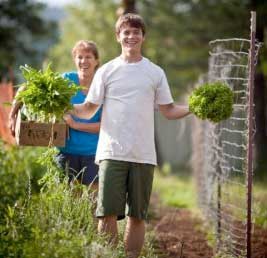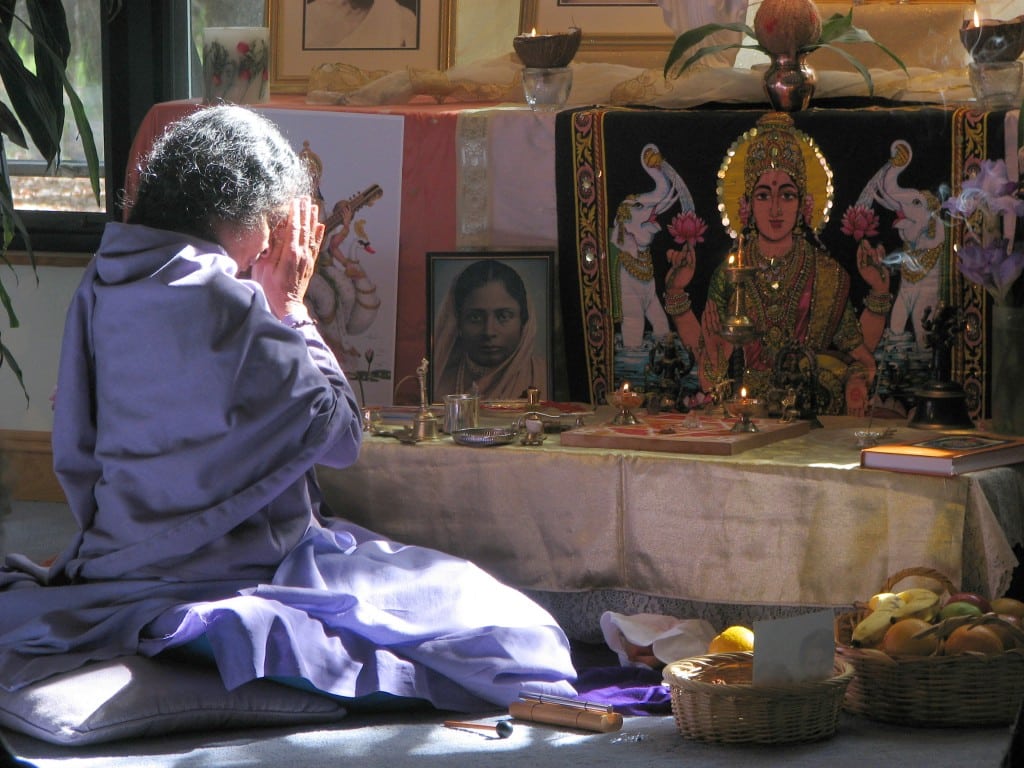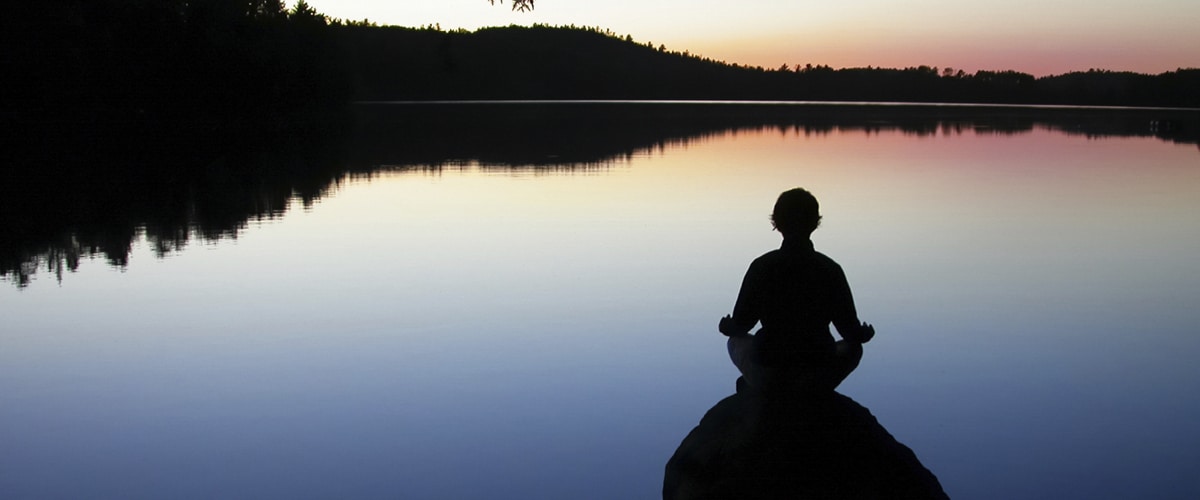There are four main paths to self-realization: karma yoga, bhakti yoga, gyana yoga, and raja yoga. “Yoga” means union with God or our higher self, and you will find these yogas emphasized in many religions.
Each of the yogas or paths is designed for people of different temperaments. Karma yoga is for people who like to serve, bhakti for people who are more loving and devotional, and gyana yoga for those who are more intellectual and philosophical. Raja yoga, the path of meditation, combines the others to address the whole of our being.
Karma Yoga: The Path of Action
 Karma yoga is the yoga of action. To perform karma yoga perfectly, you must do every action with the thought that God (or your higher self) is acting through you. When you practice karma yoga truly, you have no desire for a reward or any recognition of your actions, because you know that it was really God, not you, who was the doer. It doesn’t matter so much what you do, although it may be easier when you know that your action is benefiting someone. Mother Teresa and Gandhi are famous examples of karma yogis, and many Christians also do a form of karma yoga when they do charitable work, because they are doing it for the sake of others, and not for money or prestige. However, to be a true karma yogi you must feel that God is acting through you, and it’s not you, the small self or ego, who is acting.
Karma yoga is the yoga of action. To perform karma yoga perfectly, you must do every action with the thought that God (or your higher self) is acting through you. When you practice karma yoga truly, you have no desire for a reward or any recognition of your actions, because you know that it was really God, not you, who was the doer. It doesn’t matter so much what you do, although it may be easier when you know that your action is benefiting someone. Mother Teresa and Gandhi are famous examples of karma yogis, and many Christians also do a form of karma yoga when they do charitable work, because they are doing it for the sake of others, and not for money or prestige. However, to be a true karma yogi you must feel that God is acting through you, and it’s not you, the small self or ego, who is acting.
Your ego, which is your soul that now believes it’s a mortal body, thinks that it does everything itself and that it deserves credit for all its actions. However, if you go about your day reminding yourself that everything is a manifestation of God, either by repeating a mantra, by prayer or talking with God, or by keeping your mind focused at the spiritual eye, you will begin to know that everything you do is also a manifestation of God (even if you make a mistake). Eventually you will see that even you are a manifestation of God, as is everyone else, and you will once more be united with Him.
Bhakti Yoga: The Path of Devotion
 Bhakti yoga, the yoga of devotion, is the main focus of many religions. It’s the simplest and sweetest of the paths. Bhakti yogis merge back into God when they have attained perfect divine love. Just as it doesn’t matter what type of action is being done in karma yoga, it also doesn’t matter what the object of one’s devotion is. In Christianity it’s Jesus; in Hinduism it can be one of thousands of gods and goddesses or the one infinite God beyond creation; in Islam it’s Allah.
Bhakti yoga, the yoga of devotion, is the main focus of many religions. It’s the simplest and sweetest of the paths. Bhakti yogis merge back into God when they have attained perfect divine love. Just as it doesn’t matter what type of action is being done in karma yoga, it also doesn’t matter what the object of one’s devotion is. In Christianity it’s Jesus; in Hinduism it can be one of thousands of gods and goddesses or the one infinite God beyond creation; in Islam it’s Allah.
The key to bhakti yoga is to be nonattached to the object of your devotion. This may sound impossible, but it’s the only way to truly love. Most people only love someone else because that person makes them feel good; if that person always made them feel bad, most people would cease to love them. How many people actually love without expecting anything in return, whether their love is reciprocated or not? The truth is that each of us has the presence of God within us. To truly love another is to love the presence of God in that person. Not all of us have appealing personalities. When you can learn to love everyone and everything as part of God, you will become part of that love and merge into it.
Gyana Yoga: The Path of Wisdom
 Gyana yoga is finding God through wisdom. Gyana yogis use self-examination and ever-deepening insight to penetrate through their likes and dislikes and extract the seed of Truth. The key is not to become attached to one’s insights into profound truths, which again allows the ego to come in. There is a Sanskrit saying that describes gyana yoga: “neti neti,” meaning, “not this, not that.” Gyana yogis toss aside everything that is not eternal, until all they are left with is God.
Gyana yoga is finding God through wisdom. Gyana yogis use self-examination and ever-deepening insight to penetrate through their likes and dislikes and extract the seed of Truth. The key is not to become attached to one’s insights into profound truths, which again allows the ego to come in. There is a Sanskrit saying that describes gyana yoga: “neti neti,” meaning, “not this, not that.” Gyana yogis toss aside everything that is not eternal, until all they are left with is God.
One well-known gyana yogi is Shankaracharya. Once when he was young, he lay motionless on the floor and held his breath, pretending he was dead. He realized that although his body and breath had stopped, he was still self-aware. This led him to realize that we are not our bodies: that there is something else that is truly “us,” which survives the deaths of our bodies. The Buddha was also a gyana yogi, and many Buddhists still practice this tradition.
Raja Yoga: The Royal Path
 Raja yoga translates as the royal path to God. This is the path we practice at Ananda. Raja yoga combines the three yogas above, with an emphasis on meditation. Meditation helps to strengthen and guide each person’s practice of the other yogas to keep them heading toward God and self-realization.
Raja yoga translates as the royal path to God. This is the path we practice at Ananda. Raja yoga combines the three yogas above, with an emphasis on meditation. Meditation helps to strengthen and guide each person’s practice of the other yogas to keep them heading toward God and self-realization.
All of the yogas described above help people find a path to God that fits their natural tendencies. At the same time, all of the paths need to be included in our practice or we become one-sided. For example, practicing only bhatki yoga (devotion), but no gyana yoga (wisdom), leads to fundamentalism and fanaticism. And practicing only gyana yoga, but no karma yoga (serviceful action), can lead to pride and aloofness.
In everything you do, try to bring a blend of the yogas. As you work selflessly, try to sweeten your service with love. When you practice devotion, try to feel the expansive wisdom of gyana yoga and know that the God you love is the essence of your own Self, and of everyone you meet. Let your experience of God through the stillness of meditation bring greater depth and focus to your practice of the other yogas.
Try This
Whichever of these yogas seems to be most natural to you, make sure to practice at least a little of all four. When you go about daily activities, remember that it’s really God serving through you. When you are with your loved ones, love God in them even when you disagree with aspects of their personalities. When you feel a strong desire or get angry or frustrated, remember that those are just the likes and dislikes of your ego, which are not rooted in your soul and which you will soon forget about. And try to fit in at least 10 minutes of daily meditation, and longer as you become more experienced. This will keep your practice going in the right direction and allow you to progress much more quickly.
Further Study
The Essence of the Bhagavad Gita by Swami Kriyananda
The Art and Science of Raja Yoga by Swami Kriyananda
Raja Yoga and the Other Yogas by Nayaswami Devarshi
The Path of Karma Yoga
The Path of Kriay Yoga Online Courses
Art and Science of Raja Yoga Online Course

4 Comments
Thank you I really enjoy your articles…..
with all due respect
Talaban and Daesh members have the same feeling you express in path number one
they kill and rape people with this imagination that god is doing it and they do it with full belief
do you confirm their actions
No, we don’t condone those actions. What is intended is making effort to attune to divine will before carrying out actions. What is done, therefore, will have as uplifting results as possible and expand one’s reality with compassion toward others. Interpretation of God’s will can easily be faulty, although behavior that’s accurately following truth would best benefit everyone.